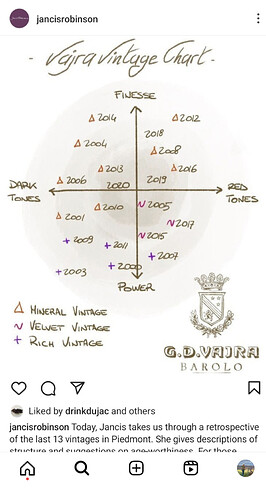Ok learned another thing about red fruits vs darker fruits from the same variety, from the same vineyard. How moist is the soil during ripening. More moist, all things being equal, ripens faster, ripens sooner. Here is Steve Doerner from Cristom (WV and pinot noir not Barolo) in an interview with Levi Dalton (I’m giving you a long quote for the context–bolded the red vs dark part below.)
As I continue to listen to Doerner discuss the different vineyards, and the altitude of each, it seems that ripening faster is more salient than ripening sooner for red vs darker fruit.
Steve Doerner 1:32:46
Well, we’re primarily volcanic, we have no kind of old marine sediments on the property. There are some of those on on the west side of Eola hills because it kind of got tilted up, you know, on the west side. So some of the old marine layer that’s under everything in the Willamette Valley was re exposed over there. But on our side it’s it’s all volcanic and it’s really just a question of depth of how Jory versus Witzel those are kind of the two extremes. We do have some sedimentary soils but they’re from the Missoula floods. They’re not marine sediments. They’re, they’re from east of us and came more recently through the last ice age. You know, when there’s some flooding huge amounts of water came rushing down the Columbia Gorge and flooded the Willamette Valley and deposited a lot of waterborne silts and stuff. On our site it’s it’s the lower altitude vineyards, primarily our Pinot Gris has some of the old sedimentary soils. But as you move further up the hill, you know it pretty soon goes exclusively to volcanic so there’s kind of a line on our vineyard that I kind of called the lakefront that would have been a lake back when those floods were happening. And it wasn’t a flood, it probably happened hundreds of times. But we think that that point is a high watermark because there’s no none of that sedimentary soil above that point.
Levi Dalton 1:34:09
Have you think the volcanic affects the flavor profile?
Steve Doerner 1:34:12
Well, there’s there’s some clay in it that I think helps to hold water a little bit better than some of the marine soils. They’re very deep soil, some of those marine sediments, but they don’t hold as much water even though they’re deeper, you know. So it kind of depends on the season, if you will, or which which one gives you the best idea, you know, the best fruit but I think I think of how it affects the fruit in terms of how much water there is and therefore when it ripens, you know. And so you’ve got the Jory version of volcanic which is quite deep and therefore it holds more water naturally. We’re not talking about irrigation right now. So I’m assuming we’re talking dry farming. So those if you were to pick them all at the same time, say you had a Jory soil and say a shallower volcanic soil on sedimentary solid, if you pick them all at the same time, the sedimentary soil would probably be a little bit riper and the and the deep volcanic soils would wouldn’t be so ripe. So you don’t have to pick them on the same day. So this is a bit of a theoretical thing anyway. But I think you get kind of those strawberry lighter, redder fruits in the in the soils that have more moisture. But if you waited long enough, you could move that into sort of the darker fruits, you know, and vice versa, you get kind of the darker fruit or more rustic things in the soils that are dried out a little faster. But we all try to pick at the ripening that we want and you don’t have to pick them on the same day. The cold wet, vintages might have, there might be an advantage in those years to be on sedimentary soils, because they’re gonna ripen a little bit earlier and faster. So I like to think which one makes the best wine is very dependent on the season. You know, if you have a very hot early season, then maybe some of the deep volcanic soils that hold more water are going to have the advantage and vice versa. If you have a cold wet year, you do want to accelerate ripening, and so you’re better off to have a very well drained soil that is maybe going to promote ripeness, and you might get it off before the season ends. And so it’s not one is better than the other. It’s just they’re both useful in a changing climate, especially when we get all these extremes
